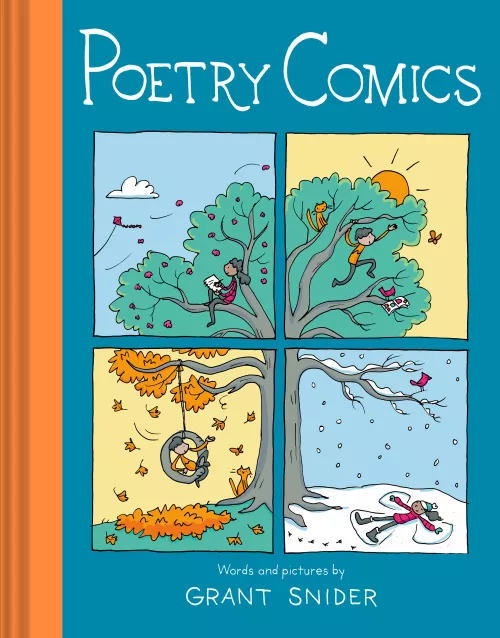Share this book
Author Grant Snider noted about the development of his book Poetry Comics: “Making poetry comics activates the observational part of my art-making brain. Instead of looking inward, I look outward. I carry my sketchbook in my backyard, around the block, to the park. If I’m lucky, these outward observations ignite inner feelings. That’s the beauty of poetry, for me: taking the ordinary and infusing it with a sense of meaning and wonder.”
Have students do the same! Start with sharing Grant Snider’s illustrated instructions on How to Make Poetry Comics, then have them gather journals and sketchbooks and head outside to a nearby green space or just to stroll the sidewalk around the school building. Ask them to observe and make notes and drawings about their experience outside the classroom—capturing the everyday sights, sounds, smells, and textures of things outdoors. Back inside, students can further ponder their observations, think about what they saw and what it meant to them, and how best to express their feelings in a poetry comic.
Then have them work through Grant Snider’s exercises to create poetry comics. Encourage kids to get creative and develop their own style, always remembering that both the text and their drawings need to make important contributions in order to create a poetry comic. Scan student work and create a bound collection to include in your classroom library and share a poetry comic a day with your students.
Questions for Discussion or Reflective Writing
- Had you ever encountered a poetry comic before reading this book? What do you think about this format for poetry? Does the author’s combination of words and drawings make it more or less well-equipped for communicating specific emotions and messages? Does a poetry comic contribute more or less to your understanding of self, others, and the world than a poem does? Why or why not?
- What familiar features of poems and poetic forms did you find in this collection? What overarching themes were present in the poems? Explain what you took away from reading this collection of poetry comics.
- How is a poem about a season different from a poetry comic about a season? How is a poetry comic about a season different from a story about a season? What are some differences between the way stories, poems, and poetry comics look and sound?
- When you listen to a poem from the book, how does the picture in your mind look compared to the poetry comic?
- Were there poetry comics that particularly stood out to you? What made those works resonate with you?
- How can you use poetry to express yourself? Do you think it would be easier for you to express yourself through a poem or through a poetry comic? Why?
Related Resources
An Intro to Poetry Comics from Grant Snider
How to Make Poetry Comics from Grant Snider
Writing Poetry with English Language Learners from Colorin Colorado
More Titles to Try
-
Neighborhood Odes
Gary Soto
-
Dictionary for a Better World: Poems, Quotes, and Anecdotes from A to Z
Irene Latham & Charles Waters
-
Everything Comes Next: Collected and New Poems
Naomi Shihab Nye
-
Hypnotize a Tiger
Calef Brown
-
Go: A Kidd's Guide to Graphic Design
Chip Kidd
-
Drawing Words & Writing Pictures: Making Comics: Manga, Graphic Novels, and Beyond
Jessica Abel and Matt Madden
Stay on top of current education news



